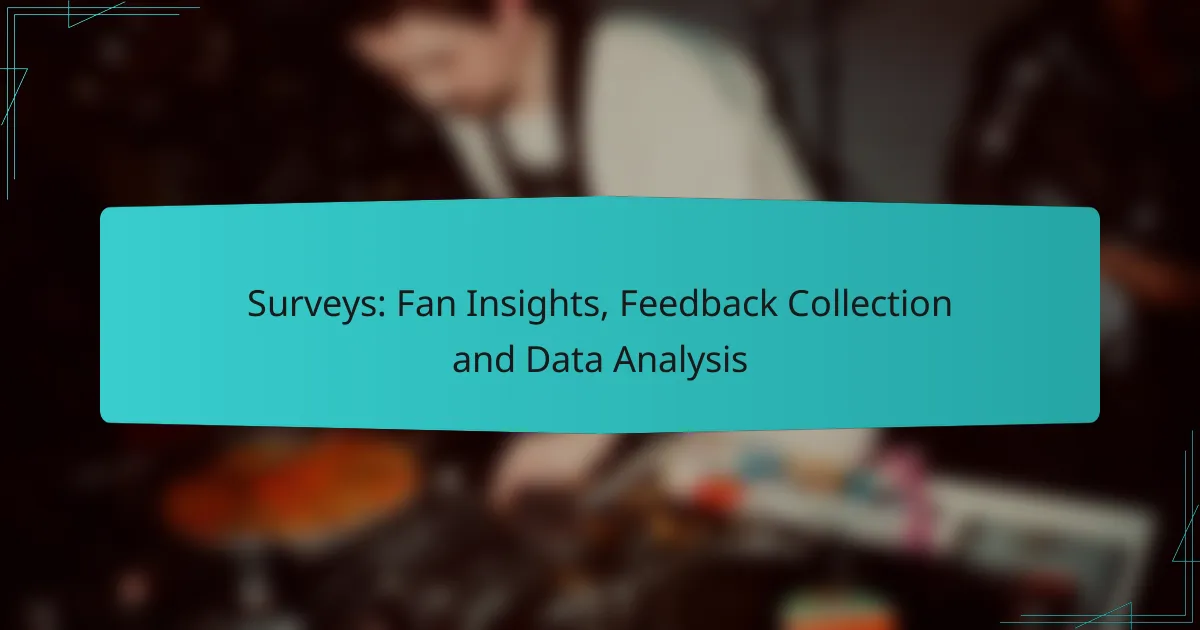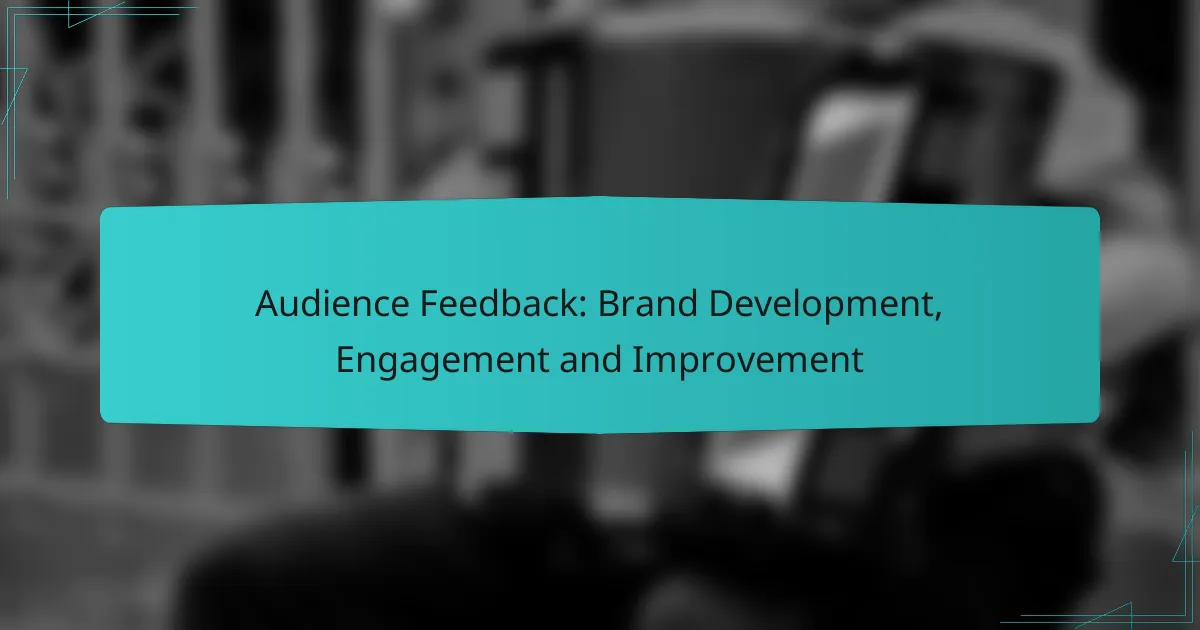Surveys play a crucial role in enhancing fan engagement by allowing supporters to express their opinions and preferences. By collecting and analyzing this feedback, organizations can tailor their services and experiences, fostering a stronger connection with their audience. Utilizing effective survey tools and proper data analysis techniques can transform raw insights into actionable strategies for improvement.

How can surveys enhance fan engagement in sports?
Surveys can significantly boost fan engagement in sports by providing a platform for fans to voice their opinions and preferences. This feedback helps organizations tailor experiences, improve services, and foster a deeper connection with their audience.
Real-time feedback collection
Real-time feedback collection allows sports organizations to gather insights immediately during events or through digital platforms. This can include quick polls during games or post-event surveys sent via email or mobile apps. The immediacy of this feedback helps teams address issues on the spot and adapt strategies to enhance the fan experience.
Consider using tools like live polling during broadcasts or interactive social media questions to engage fans actively. Aim for concise surveys that take only a few minutes to complete, ensuring higher response rates.
Personalized fan experiences
Surveys enable sports teams to create personalized fan experiences by understanding individual preferences and behaviors. By analyzing survey data, organizations can tailor promotions, merchandise, and event experiences to match fan interests. This personalization can lead to increased loyalty and higher attendance rates.
For example, if a survey reveals that fans prefer certain types of merchandise or specific game-day activities, teams can adjust their offerings accordingly. Implementing targeted marketing strategies based on survey insights can significantly enhance fan satisfaction.
Data-driven decision making
Data-driven decision making relies on insights gathered from surveys to inform strategic choices in sports management. By analyzing trends and feedback, organizations can identify areas for improvement and allocate resources more effectively. This approach ensures that decisions are grounded in actual fan preferences rather than assumptions.
For effective data analysis, consider segmenting survey responses by demographics or engagement levels. This can help pinpoint specific fan groups and tailor strategies to meet their unique needs, ultimately leading to better overall engagement.

What are the best tools for survey creation?
The best tools for survey creation offer a blend of customization, ease of use, and effective distribution methods. Popular options include SurveyMonkey, Google Forms, and Typeform, each catering to different needs and preferences.
SurveyMonkey for customizable surveys
SurveyMonkey is renowned for its extensive customization options, allowing users to create surveys that align closely with their branding and specific research goals. It offers various question types, including multiple-choice, open-ended, and rating scales, making it versatile for different survey objectives.
When using SurveyMonkey, consider the pricing tiers, as advanced features like logic jumps and detailed analytics may require a paid subscription. For small businesses, the basic plan can suffice, but larger organizations might benefit from the premium options for deeper insights.
Google Forms for easy distribution
Google Forms is a user-friendly tool that excels in survey distribution, especially for those already using Google Workspace. It allows users to create surveys quickly and share them via email or links, making it ideal for gathering feedback from a wide audience.
One key advantage of Google Forms is its integration with Google Sheets, enabling real-time data analysis and easy collaboration. While it may lack some advanced features of other tools, its simplicity and cost-effectiveness (free for users) make it a solid choice for many.
Typeform for engaging user interfaces
Typeform stands out for its visually appealing and interactive survey designs, which enhance user engagement. The platform uses a one-question-at-a-time approach, making the survey-taking experience more conversational and less overwhelming.
When considering Typeform, keep in mind that while it offers a free tier, many of its more engaging features are locked behind paid plans. This makes it a great option for businesses looking to create a memorable survey experience, but budgeting for the premium features is essential for full functionality.

How to analyze survey data effectively?
To analyze survey data effectively, start by organizing the data and applying appropriate statistical methods to extract meaningful insights. This process involves using software tools, visualizations, and interpretation techniques to translate raw data into actionable information.
Using statistical software like SPSS
Statistical software such as SPSS is essential for analyzing survey data, allowing users to perform complex statistical tests and manage large datasets efficiently. Key features include descriptive statistics, regression analysis, and hypothesis testing, which help identify trends and relationships within the data.
When using SPSS, ensure your data is clean and well-structured. Common pitfalls include missing values and incorrect data types, which can skew results. Familiarize yourself with SPSS’s syntax and output interpretation to maximize your analysis capabilities.
Visualizing data with Tableau
Tableau is a powerful tool for visualizing survey data, enabling users to create interactive dashboards and compelling visual representations. Effective visualizations can highlight trends, patterns, and outliers, making it easier to communicate findings to stakeholders.
When visualizing data, focus on clarity and relevance. Use charts and graphs that best represent your data, such as bar charts for comparisons or line graphs for trends over time. Avoid cluttered visuals; instead, aim for simplicity to enhance understanding.
Interpreting results for actionable insights
Interpreting survey results involves translating statistical findings into actionable insights that can inform decision-making. Look for significant patterns and correlations that can guide strategic initiatives, such as improving customer satisfaction or refining product offerings.
To ensure effective interpretation, consider the context of the data and the target audience. Use clear language and avoid jargon when presenting insights. Additionally, validate findings with qualitative data or follow-up surveys to strengthen conclusions and recommendations.

What are the key metrics to measure fan satisfaction?
Key metrics for measuring fan satisfaction include Net Promoter Score (NPS), Customer Satisfaction Score (CSAT), and engagement rates from survey responses. These metrics provide insights into how fans perceive their experiences and can guide improvements in services and offerings.
Net Promoter Score (NPS)
Net Promoter Score (NPS) gauges fan loyalty by asking how likely they are to recommend your brand to others on a scale from 0 to 10. Scores are categorized into promoters (9-10), passives (7-8), and detractors (0-6), allowing organizations to calculate their overall score by subtracting the percentage of detractors from promoters.
A high NPS indicates strong fan loyalty, while a low score suggests areas for improvement. Regularly tracking NPS can help identify trends over time and measure the impact of changes made to enhance fan experiences.
Customer Satisfaction Score (CSAT)
Customer Satisfaction Score (CSAT) measures how satisfied fans are with a specific interaction or experience, typically assessed through a simple survey question. Fans rate their satisfaction on a scale, often from 1 to 5 or 1 to 10, with higher scores reflecting greater satisfaction.
CSAT is valuable for pinpointing specific areas of strength or weakness in fan interactions. Aim for a CSAT score above 80% to indicate a generally positive experience, and regularly review feedback to address any recurring issues.
Engagement rates from survey responses
Engagement rates from survey responses indicate how actively fans participate in feedback opportunities. This can include the percentage of fans who complete surveys or the depth of their responses. High engagement rates suggest that fans feel valued and are willing to share their opinions.
To improve engagement, consider incentivizing participation through rewards or exclusive content. Monitoring engagement rates over time can help assess the effectiveness of your outreach strategies and identify which surveys resonate most with your audience.

What are the best practices for survey distribution?
Effective survey distribution involves strategically selecting channels to reach your audience and maximize response rates. Utilizing targeted methods ensures that your surveys reach the right participants, leading to more relevant insights and feedback.
Targeted social media campaigns
Targeted social media campaigns can significantly enhance survey visibility among specific demographics. By using platforms like Facebook, Instagram, or Twitter, you can tailor your messaging to resonate with your audience’s interests and behaviors.
Consider using paid ads to boost your survey’s reach, focusing on age, location, and interests. A/B testing different ad formats and messages can help identify what drives the highest engagement and response rates.
Email marketing for existing fans
Email marketing is a powerful tool for reaching existing fans who are already engaged with your brand. Sending personalized survey invitations to your email list can yield higher response rates compared to general outreach.
Segment your email list based on user behavior or preferences to tailor your survey invitations. Aim for concise, compelling subject lines and clear calls to action, encouraging recipients to participate. Regularly cleaning your email list can also improve deliverability and engagement rates.



